Living With an Interceptor

Familiarity Breeds Fondness
When I realized that my days were numbered with my unofficial long-term Yamaha FJR1300ES, I began to wonder what I would do without it. Over a period of about nine months, I’d become quite accustomed to having hard bags and sporting performance at my disposal on a daily basis. As my thoughts turned to a worthy replacement, I began to consider the Honda Interceptor I’d ridden at its introduction back in June. The initial high demand for journalist bikes was over. So, perhaps, Honda was willing to keep a 2014 model on the books into 2015 to allow me to park it in my driveway and have some fun riding and modifying it – all for your edification, of course. Really, I was just thinking about you readers.
Why step down in size from a 1300 to an 800? Well, although I loved the massive torque of the FJR, I’m a middleweight bike guy at heart. I figured that what I’d give up in power would be countered by the lessened heft. Yes, I’d also be losing some other things (like cruise control and electronically adjustable suspension), but I was thinking that lighter weight and an easier reach to the ground from the saddle would make my daily motorcycle life more enjoyable. And I was right.
Daily Ride Versus a Day’s Ride
Manufacturers design their bike introductions to give the press a taste of all a bike’s strong points while minimizing its shortcomings. My time with the Interceptor hasn’t changed my initial impression of the bike. It has, however, given me more time to uncover idiosyncrasies that only become apparent with familiarity. For example, the abruptness that occurs at low rpm is much more frequent than I noticed on the introductory ride. The reason is quite simply that, as a daily rider, the Interceptor spends more time in stop-and-go traffic where the engine has to loaf along in the bottom end. This is more a statement of real world use than a criticism of the EFI. The on-throttle transitions are still buttery smooth when railing into corners where abruptness would upset the chassis.
On a similar vein, as I noted in my First Ride Review, the VTEC shift from two operational valves per cylinder to four at 7,000 rpm causes the rate of acceleration to actually slow noticeably at partial throttle. So, I’ve incorporated this into my urban highway riding, generally shifting just before 7,000 unless I’m accelerating briskly enough to utilize the extra power of the freer breathing combustion chambers – which, because of the sexy intake noise, I do as often as possible.
While I’m discussing acceleration, I should mention the Honda Accessory Quick Shift Gear Change Pedal is the bomb. No, it’s not necessary, and the $300 price tag may put some people off. However, I can only say that the fun factor of riding the V-4 increases exponentially. I can’t ride a freeway entrance ramp without ripping through a series of full-throttle upshifts, putting a huge smile on my face as the VTEC/V-4 howl fills my ears. The result is that I always have to slow down to merge in with the traffic – though still smiling. The longer I ride the Interceptor with the quick shifter, the more I use it. Though the engine cutout clearly works better at larger throttle openings, toeing the pedal from fifth to sixth at neutral throttle on the highway is something I find myself doing more frequently.
Beast of Burden
At the Interceptor’s introduction, the accessory bags were not available for the motopress to sample. Well, they are an essential part of my daily use of the Honda. The bags are keyed to the ignition key, so there’s not extra stuff dangling off the bike’s fob to mar the finish of the triple clamp. Operation of the bags is about what you’d expect. Unlock one, and you have the choice of using one lever to open the bag or lifting the handle for easy removal from the motorcycle. I particularly like how the interior retaining straps have a clip that keeps the bag from opening all the way, keeping smaller items from tumbling out of the left bag when the bike is on its side stand. When you have a larger item that needs the whole opening, just unclip the strap, and the bag opens a full 90 degrees.
The 29-liter bags hold plenty of gear, though not my full-face helmet. I just keep my Kryptonite cable lock in a bag and secure my helmet to the bike with it on those occasions that I don’t want to carry it. The bags are slightly wider than the grips, so I needed to get used to the extra space required when splitting lanes through traffic. I’ve ridden through some pretty heavy rain with my Macbook Air in a saddlebag, and as I expected from Honda, the bag was water-tight. Without hesitation, I’d include $950 price for the color-matched bags in my purchase cost of the Interceptor.
After riding the Interceptor for a while, I did what many would consider to be a sacrilege among sport-touring types: I ordered a trunk. Since saddlebags don’t provide a good working access to camera gear, I’m frequently hauling it on my back. I began to wonder if setting up a trunk as quick access to my most commonly used camera body and lenses would help me work quicker out on the road. So, I talked to the good folks in Honda’s media department, and a trunk and its mounting hardware landed on my doorstep. About an hour after that, my Interceptor had a spiffy, red trunk mounted on its rear.
Because this is a sport-touring rig, don’t expect the same capacity of a Harley-Davidson Tour Pack. However, any bigger than the trunk’s 33-liter capacity would look out of place on the Interceptor. Still, it swallows my XL Shoei RF-1200 with some room to spare. A quick trip to my local foam supply house allowed me to craft secure storage for my photo gear in transit. Although the combined weight of the camera and lenses is slightly more than the trunk’s corporate lawyer crafted limit of 13 lb., I’ve noticed no ill effects in the bike’s handling. As with any additional weight at the rear of the bike, the preload needed to be bumped up – a 10-second affair with the Interceptor DLX’s easy-to-reach remote shock preload adjuster.
The value of the trunk for the average user is a more difficult call than the bags. The price breakdown is: $375 for the trunk, $400 for the trunk base, $370 for the trunk carrier/grab rail, $20 for the key cylinder, and $10 for the key body parts. For my purposes, the $1,175 total seems a bit high, but I would still probably do it since I gain a more workable environment when shooting out on the road. (Also, if I were still freelance, I’d write it off as a business expense.) People who frequently commute in an urban environment (and want easier lane splitting or require full-face-helmet storage) might find utility in removing the saddlebags in favor of the trunk for the daily grind.
Sitting Up in the Saddle
In my review of the Interceptor, I noted that Honda offers a set of $120 handlebar risers that moves the grips 0.53 in. higher and 0.26 in. rearward. During my travels on the net, I also discovered that MotoPumps makes two sets of risers (0.6 in. and 1.25 in.) for relocating the grips. So, I got the Honda items and the larger MotoPumps ones to see how they stacked up.
Being a factory accessory, the Honda accessory risers’ finish exactly matches that of the triple clamp and handlebar risers. The MotoPumps’ risers do a decent job of matching the color but not the texture. However, you really have to be looking for the risers to be able to see them.
When installing both riser sets, it takes more time to gather the tools than actually mount the parts. Simply, remove the riser bolts, lift the stock grip up to free the riser, slip the riser extension in place over the fork tube, lower the riser back down, and torque to spec. Easy peasy. The Honda riser subtly alters the riding position for increased comfort over a long stint. The MotoPumps 1.25 in. riser, unsurprisingly, delivers a decidedly more upright torso. Around town where there is no wind blast to take the weight off your wrists in the stock position, the placement is particularly noticeable. Out on the highway, I found that, for both risers in situations where I was riding at elevated speeds (or against a headwind), I ended up tucking down to the original riding position to combat the wind. (I’ll be looking for a taller windscreen for my next update about the Interceptor.)
In a perfect world – and I’m splitting hairs, here, because it’s my job – I’d want a riser that was between these two examples. As much as I liked the additional height of the MotoPumps version when riding around town, I felt it was a bit too high during a freeway drone. The ultimate decision about the height depends on the condition of the rider’s back and how upright one may need to sit.
There’s a characteristic of the MotoPumps version that should be addressed: When the 1.25 in. riser is installed, the fork stanchions no longer reach into the stock bar riser, leaving the two stainless steel bolts to secure the controls without an assist from the fork. I have to wonder if this would make the stock riser more vulnerable to bending/breaking in an off-the-sidestand tip over. Visually, some people may not like that the top of the fork is located a half-inch inside the risers. MotoPumps says that the fork can be raised inside the triple clamp to address this issue, but be aware that, while it will address the above two concerns, it will quicken the steering and slightly affect ground clearance.
For riders who wish to lessen their reach to the grips, these risers offer a great option, and unless having the exact finish is required, the MotoPumps 0.6 in. riser would be a good option since its retail price of $70 is $50 less than the Honda item. If you want more height, the $76 MotoPumps’ 1.25 in. riser is currently the only game in town.
More to Come
In the 1,100 miles I’ve logged on the Interceptor, I’ve become even more fond of it than I was at the introduction. While I’ve heard some people claim it’s not sporty enough and others say it’s too sporty to be a comfortable sport-tourer, I think Honda did a great job of managing the two conflicting job requirements. For those who track these sort of things, my average mpg for the Interceptor has been 43.4, giving a theoretical range of over 240 miles per tank – though I’ve only pushed it to 230 mi. In other brief notes: Thank God for hand warmers. The DLX’s ABS and TC are fabulous in wet weather.
So, what’s next with the Interceptor? I’m thinking a taller windscreen to match my new riding position and an aftermarket pipe to try to get the exhaust note to sing along with the intake honk that I like so much. We’ll see what else pops up along the way.

Like most of the best happenings in his life, Evans stumbled into his motojournalism career. While on his way to a planned life in academia, he applied for a job at a motorcycle magazine, thinking he’d get the opportunity to write some freelance articles. Instead, he was offered a full-time job in which he discovered he could actually get paid to ride other people’s motorcycles – and he’s never looked back. Over the 25 years he’s been in the motorcycle industry, Evans has written two books, 101 Sportbike Performance Projects and How to Modify Your Metric Cruiser, and has ridden just about every production motorcycle manufactured. Evans has a deep love of motorcycles and believes they are a force for good in the world.
More by Evans Brasfield










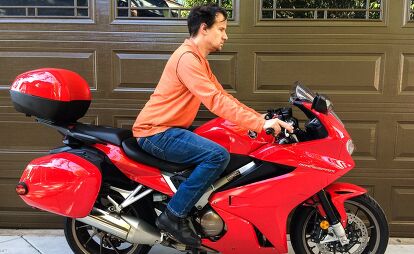








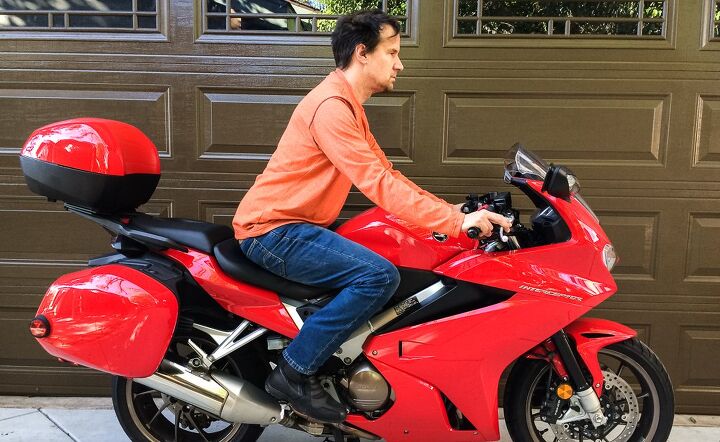








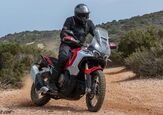


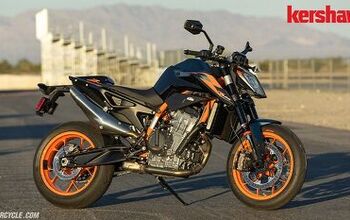











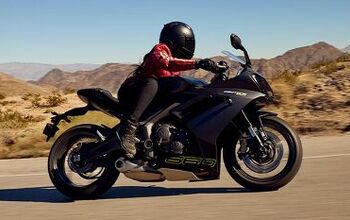

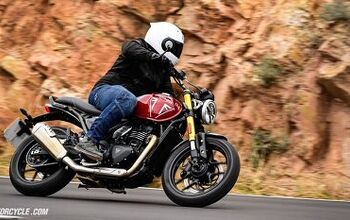

Comments
Join the conversation
Looks painful. I'd rather have the new RT with the 49L topcase, but that's me.
Hey Evans, thanks for the great review. Since you wrote this, it looks like motopumps has changed to a .95 and a 1.25 riser; they dropped the .6. Which one would you recommend?